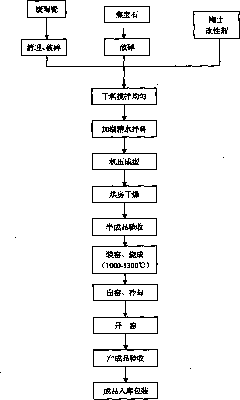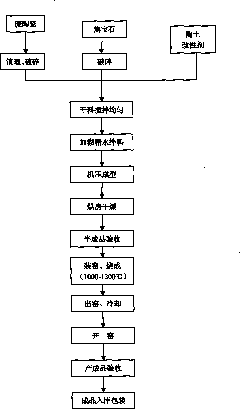Fire, wear and acid resistant clinkery brick and preparation method thereof
A refractory, wear-resistant and clinker brick technology, which is applied in the manufacture of refractory materials and the field of refractory, wear-resistant and acid-resistant clinker bricks, can solve the problems of affecting the normal production of coking coal, increasing production costs, and low service life, so as to achieve low cost and prolong service life , the effect of low wear rate
- Summary
- Abstract
- Description
- Claims
- Application Information
AI Technical Summary
Problems solved by technology
Method used
Image
Examples
Embodiment 1
[0013] Such as figure 1 As shown, the waste ceramics are cleaned and crushed to a particle size of 0.01-5mm, the burnt gems are crushed to a particle size of 0.01-5mm, and the clay and modifier are ground to a particle size of 0.01-0.074mm; after that, 30% of the waste ceramics, 45% of burnt gemstone, 10% of pottery clay and 15% of modifying agent are dry-mixed evenly, and in the modifying agent, the mullite phase is 40%, and the high-silicon vitreous body is 60%. Then add 2% dextrin water mixture of the total weight of the above-mentioned dry materials, the dextrin water concentration is 30%, press molding in a high-tonnage press; then dry in a drying room at 30-60°C for 3 days, and enter the tunnel kiln Fire at a high temperature of 1000-1300°C for 4 hours; leave the kiln to cool and pass the inspection to obtain the finished product.
Embodiment 2
[0015] The waste ceramics are cleaned and crushed to a particle size of 0.01-5mm, the burnt gems are crushed to a particle size of 0.01-5mm, and the clay and modifier are ground to a particle size of 0.01-0.074mm; after that, 55% of the waste ceramics and 20% of the Burnt gemstone, 15% pottery clay and 10% modifier are dry-mixed evenly, and the modifier includes 60% mullite phase and 40% high-silicon glass body. Then add 5% dextrin water mixture of the total weight of the above-mentioned dry materials, the dextrin water concentration is 60%, and press it in a high-tonnage press; then dry it in a drying room at 30-60°C for 5 days, and then enter the tunnel kiln Fire at a high temperature of 1000-1300°C for 8 hours; leave the kiln to cool and pass the inspection to obtain the finished product.
Embodiment 3
[0017] The waste ceramics are cleaned and crushed to a particle size of 0.01-5mm, the burnt gems are crushed to 0.01-5mm, and the clay and modifier are ground to a particle size of 0.01-0.074mm; after that, 45% of the waste ceramics, 35% of the burnt gemstones, and 12 % pottery clay and 8% modifier are dry-mixed evenly, and the modifier contains 50% of mullite phase and 50% of high silica glass body. Then add 4% dextrin water mixture of the total weight of the aforementioned dry material, the dextrin water concentration is 50%, and press it in a high-tonnage press; then dry it in a drying room at 30-60 ° C for 4 days, and then enter the tunnel kiln Fire at a high temperature of 1000-1300°C for 6 hours; leave the kiln to cool and pass the inspection to obtain the finished product.
[0018] In the present invention, waste ceramics (most of which are molded by grouting, glazed on the surface, and have a refractoriness greater than 1500° C.) are used as part of the raw materials. ...
PUM
| Property | Measurement | Unit |
|---|---|---|
| particle size | aaaaa | aaaaa |
| particle size | aaaaa | aaaaa |
| flame retardant | aaaaa | aaaaa |
Abstract
Description
Claims
Application Information
 Login to View More
Login to View More - R&D
- Intellectual Property
- Life Sciences
- Materials
- Tech Scout
- Unparalleled Data Quality
- Higher Quality Content
- 60% Fewer Hallucinations
Browse by: Latest US Patents, China's latest patents, Technical Efficacy Thesaurus, Application Domain, Technology Topic, Popular Technical Reports.
© 2025 PatSnap. All rights reserved.Legal|Privacy policy|Modern Slavery Act Transparency Statement|Sitemap|About US| Contact US: help@patsnap.com


